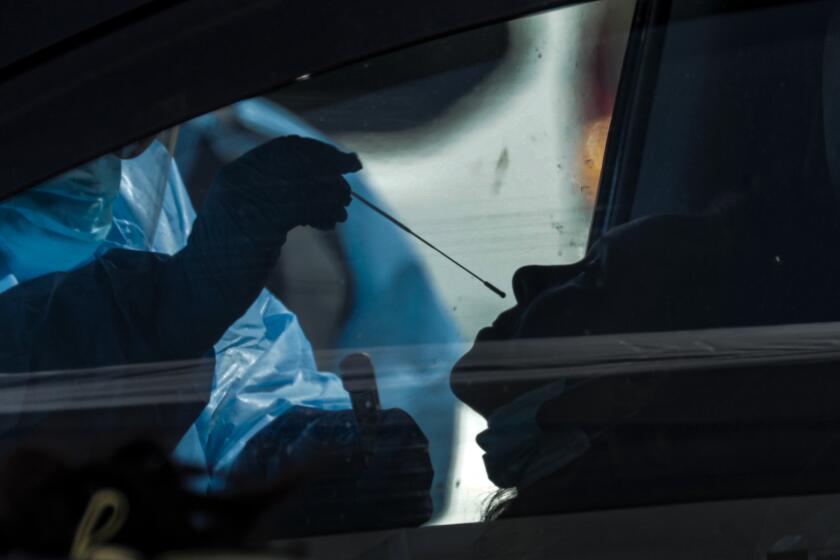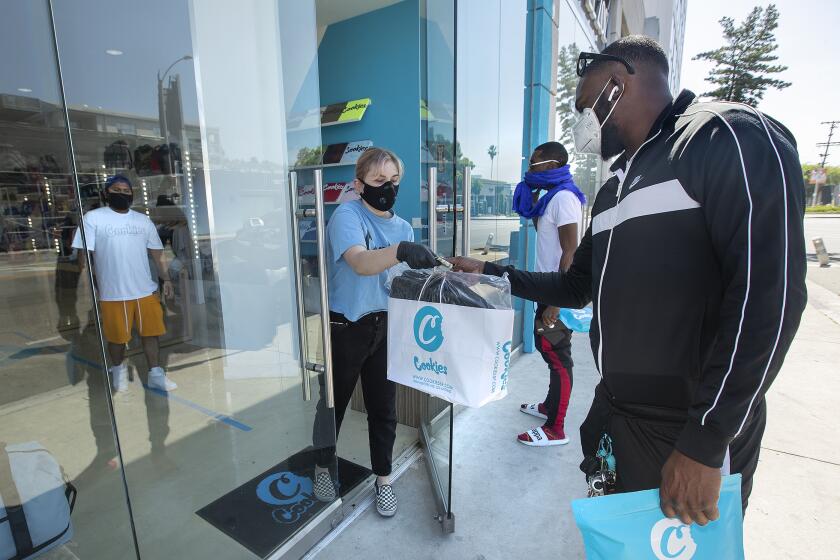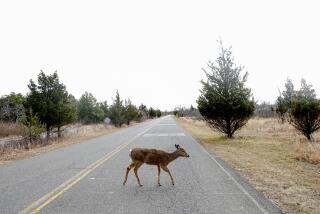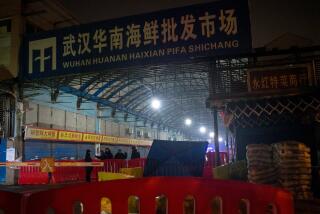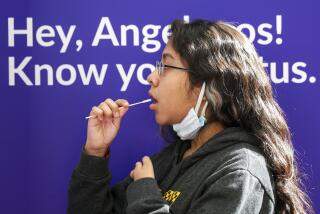Will asymptomatic spread turn Trump’s Tulsa rally into a COVID-19 party?
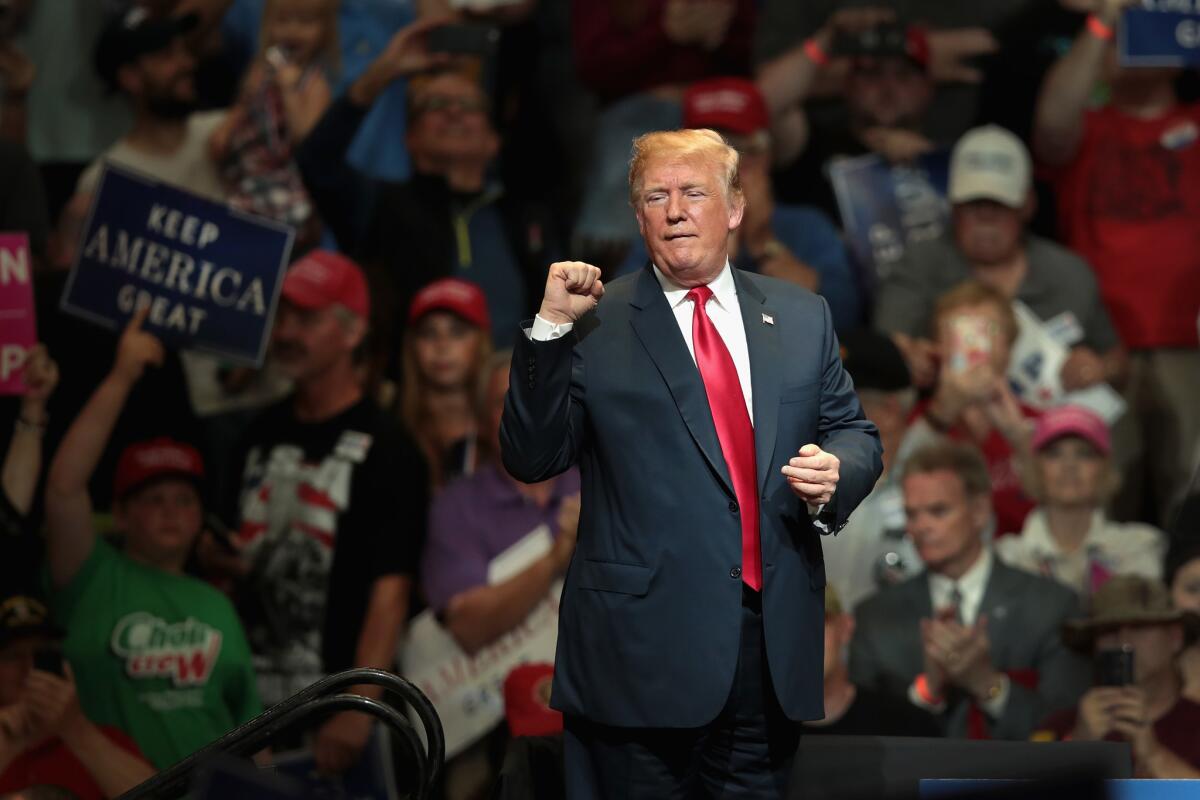
- Share via
Tulsa, Okla., is about to host an event that scientists call a “natural experiment.” It may offer important clues about one of the COVID-19 pandemic’s most perplexing features: The undetected spread of the novel coronavirus by people who do not appear to be sick.
At least 20,000 admirers of President Trump are expected to converge on the city’s Bank of Oklahoma Center, where they will be packed closely together for several hours. Once indoors, they will sing, whoop and shout — all recognized as highly efficient means of propelling the coronavirus into the air, where it can be drawn in by people nearby.
Health experts are confident that the potentially deadly pathogen will jump from infected people who show no outward signs of illness to others who entered the arena virus-free.
If recent trends in Oklahoma hold steady, 2.1% of those who become sick enough to be diagnosed with COVID-19 will die. And 41% of Oklahomans are at risk of becoming critically ill if infected by virtue of their age or underlying health conditions.
Bruce Dart, Tulsa County’s top health official, has expressed concern about “our ability to protect anyone who attends a large indoor event.” The Trump campaign said every attendee will be offered hand sanitizer and a mask, but neither will be required.
Though the infection events in Tulsa will be unseen, they will take place in full view of a national audience. But only with time, testing and assiduous contact tracing will researchers be able discern the dynamics of the virus’ spread and tally its ultimate toll.
Expelled in the respiratory droplets of an infected person, the coronavirus that causes COVID-19 has firmly established itself in and around Tulsa. In Tulsa County, daily confirmed infections have spiked since late May, reaching 130 per day in a community of about 650,000. Close to 15% of confirmed patients end up in the hospital, and 65 people there have died of COVID-19 so far.
Still, between Friday and Sunday of this weekend, tens of thousands of people will leave their homes and make their way to a variety of mass gatherings.
Some of those attending the president’s rally Saturday night are sure to wear face coverings, which can impede both the projection of respiratory droplets and their inhalation by nearby people. But many will be disinclined to don such protection. Indeed, the event’s headliner has long derided the wearing of face masks. (On Thursday, Trump asserted that some have adopted the practice to express their disapproval of him.)
Attendees will have to line up for hours and submit to temperature checks as they enter, in a bid to bar those with active infections. Plenty will still be missed: somewhere between 25% and 50% of those infected have neither a fever nor any other notable symptoms. Yet several studies have shown that many can and do infect others.
A study of COVID-19 patients and the people they likely infected suggests the coronavirus can spread for more than two days before symptoms appear.
Rhetoric to the contrary, the coronavirus does not appear to recognize political leanings. So thousands of others in Tulsa will become guinea pigs as well as they gather at events to protest Trump, oppose racism and commemorate Juneteenth, the anniversary of enslaved Texans’ learning of their emancipation.
These subjects in the city’s natural experiment also will pack themselves together within the range of respiratory droplets’ spread. But they will largely gather outdoors, where virus-packed droplets fall from the air more quickly and thus spread less efficiently.
Though their ages and ethnicities will range widely, they will probably trend younger and more heavily African American and Latino than the crowd that turns out for Trump. Experts predict that many, but not all, will wear masks at the urging of public health officials.
Once reconstructed and analyzed by researchers, the events of this weekend and the consequences beyond could help them unlock some secrets about an epidemic that has caused nearly 120,000 deaths in the United States and 458,000 across the world.
Asymptomatic spread has emerged as one of the pandemic’s most surprising and perplexing challenges. Emerging patterns of spread have defied the expectations of epidemiologists, who now wonder whether the COVID-19 outbreak will be a historic first: a pandemic driven by spreaders who have no idea they are sick.
One of the biggest challenges in trying to contain the coronavirus is that an unknown number of people are spreading it when they don’t even seem sick themselves.
In January, Dr. Anthony Fauci, director of the National Institute of Allergy and Infectious Diseases, said viral spread by people without symptoms has historically “never been the driver of outbreaks.”
That was then, this is now, he said recently.
“In fact, if you look at the data and percentage of people who aren’t symptomatic — anywhere from 25% to 50% — it is likely that they are playing a role, and maybe a significant role, in transmission,” Fauci said.
Multiple studies point to the likelihood of contagion from people who are infected but either do not get sick or have not yet developed symptoms.
A Chinese study published in the journal Nature found that people infected with coronavirus are probably shedding it for close to 2½ days before their first signs of illness appear, the scientists found. The contagion of an infected person reaches its peak roughly 18 hours before fever, body ache or coughing begin, they found.
Another Chinese study published in the Journal of Infection tracked a single 22-year-old male who returned from Wuhan to Anhui province early in the pandemic. He passed the virus to eight others in the two days before he noticed the first signs of his own illness: itchy eyes and fever.
Other studies have hinted at the prospect that asymptomatic transmission is substantial. When the Theodore Roosevelt pulled into Guam for an emergency medical stop and all personnel aboard the aircraft carrier were tested, roughly 1,000 of 4,800 were found to have been infected. Far fewer were reported to have been sick, suggesting the virus was readily passed among people with few or no symptoms.
Cities and states are pressing ahead with plans to do so. But has anything changed about the coronavirus that makes it safer to go out now?
The researchers planning to study the dynamics of viral transmission in Tulsa have not yet come forward with a plan, said William Hanage, an epidemiologist at Harvard. Uneven access to tests — either to diagnose infection or detect a past infection — will make it hard for any team to get a reliable fix on the subject, he said.
Getting a better grip on asymptomatic transmission will take “very intensive contact tracing” of a population that is both limited and contained, Fauci said. He suggested that close surveillance and testing of people in nursing homes, prisons and aboard ships like the Roosevelt could help epidemiologists understand how much “silent spreaders” are responsible for surges in the pandemic.
One such research project from Rutgers University will track 500 healthcare workers who are regularly exposed to the coronavirus, along with 540 of their household members. All of them will be questioned and tested regularly for several months. Their transmission rates and trends will be compared with a group of non-healthcare workers.
Another study launched in April could help clarify how much the kind of talking, shouting and cheering that occurs at rallies and protests is contributing to coronavirus spread, and how much a mask can help squelch such spread.
Researchers from the National Institutes of Health will have 60 subjects with likely or confirmed infections but no symptoms participate in a speaking exercise with and without a mask. The droplets they produce will be collected and analyzed, and participants will be tracked to see whether and when they develop symptoms.
